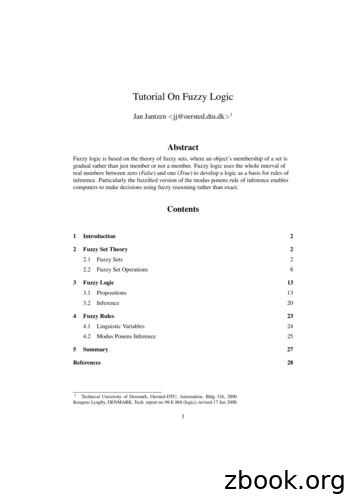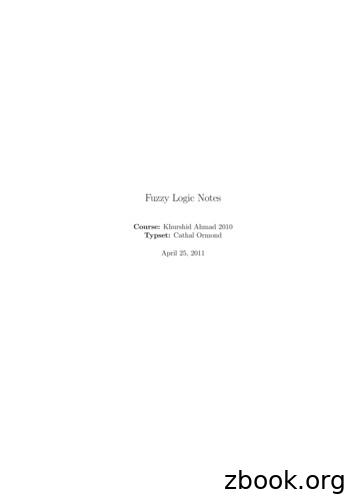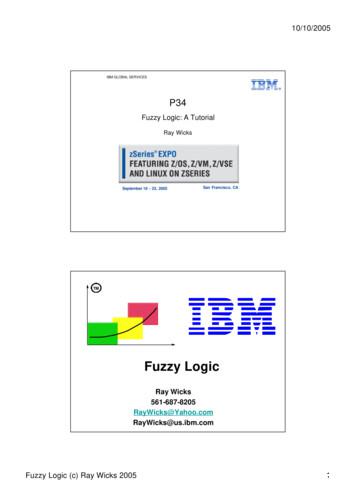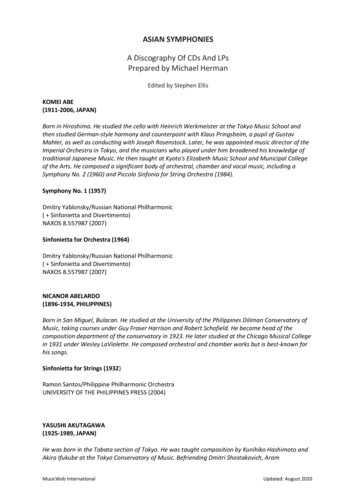Tutorial On Fuzzy Logic - 123seminarsonly
Tutorial On Fuzzy LogicJan Jantzen jj@oersted.dtu.dk 1AbstractFuzzy logic is based on the theory of fuzzy sets, where an object’s membership of a set isgradual rather than just member or not a member. Fuzzy logic uses the whole interval ofreal numbers between zero (False) and one (True) to develop a logic as a basis for rules ofinference. Particularly the fuzzified version of the modus ponens rule of inference enablescomputers to make decisions using fuzzy reasoning rather than exact.Contents1Introduction22Fuzzy Set Theory22.1Fuzzy Sets22.2Fuzzy Set Operations8345Fuzzy Logic133.1Propositions133.2Inference20Fuzzy Rules234.1Linguistic Variables244.2Modus Ponens Inference25Summary27References281 Technical University of Denmark, Oersted-DTU, Automation, Bldg 326, 2800Kongens Lyngby, DENMARK. Tech. report no 98-E 868 (logic), revised 17 Jun 2008.1
1 IntroductionAn assertion can be more or less true in fuzzy logic. In classical logic an assertion iseither true or false — not something in between — and fuzzy logic extends classical logicby allowing intermediate truth values between zero and one. Fuzzy logic enables a computerto interpret a linguistic statement such as’if the washing machine is half full, then use less water.’It adds intelligence to the washing machine since the computer infers an action from a set ofsuch if-then rules. Fuzzy logic is ’computing with words,’ quoting the creator of fuzzy logic,Lotfi A. Zadeh.The objective of this tutorial is to explain the necessary and sufficient parts of the theory,such that engineering students understand how fuzzy logic enables fuzzy reasoning bycomputers.2 Fuzzy Set TheoryFuzzy sets are a further development of mathematical set theory, first studied formallyby the German mathematician Georg Cantor (1845-1918). It is possible to express mostof mathematics in the language of set theory, and researchers are today looking at theconsequences of ’fuzzifying’ set theory resulting in for example fuzzy logic, fuzzy numbers,fuzzy intervals, fuzzy arithmetic, and fuzzy integrals. Fuzzy logic is based on fuzzy sets,and with fuzzy logic a computer can process words from natural language, such as ’small’,’large’, and ’approximately equal’.Although elementary, the following sections include the basic definitions of classical settheory. This is to shed light on the original ideas, and thus provide a deeper understanding.But only those basic definitions that are necessary and sufficient will be presented; studentsinterested in delving deeper into set theory and logic, can for example read the book by Stoll(1979[10]); it provides a precise and comprehensive treatment .2.1Fuzzy SetsAccording to Cantor a set X is a collection of definite, distinguishable objects of ourintuition which can be treated as a whole. The objects are the members of X . The concept’objects of our intuition’ gives us great freedom of choice, even sets with infinitely manymembers. Objects must be ’definite’: given an object and a set, it must be possible todetermine whether the object is, or is not, a member of the set. Objects must also be’distinguishable’: given a set and its members, it must be possible to determine whether anytwo members are different, or the same.The members completely define a set. To determine membership, it is necessary that thesentence ’x is a member of X ’, where x is replaced by an object and X by the name of a set,is either true or false. We use the symbol and write x X if object x is a member of theset X . The assumption that the members determine a set is equivalent to saying: Two setsX and Y are equal, X Y, iff (if and only if) they have the same members. The set whosemembers are the objects x1 , x2 , . . . , xn is written{x , x , 2. . . , x } .12n
In particular, the set with no members is the empty set symbolized by . The set X isincluded in Y,X Yiff each member of X is a member of Y. We also say that X is a subset of Y, and it meansthat, for all x, if x X , then x Y. The empty set is a subset of every set.Almost anything called a set in ordinary conversation is acceptable as a mathematicalset, as the next example indicates.Example 1 Classical setsThe following are lists or collections of definite and distinguishable objects, and thereforesets in the mathematical sense.(a) The set of non-negative integers less than 3. This is a finite set with three members{0, 1, 2}.(b) The set of live dinosaurs in the basement of the British Museum. This set has nomembers, it is the empty set .(c) The set of measurements greater than 10 volts. Even though this set is infinite, it ispossible to determine whether a given measurement is a member or not.(d) The set {0, 1, 2} is the set from (a). Since {0, 1, 2} and {2, 1, 0} have the same members, they are equal sets. Moreover, {0, 1, 2} {0, 1, 1, 2} for the same reason.(e) The members of a set may themselves be sets. The setX {{1, 3} , {2, 4} , {5, 6}}is a set with three members, namely, {1, 3} , {2, 4} , and {5, 6} . Matlab supports sets of sets,or nested sets, in cell arrays. The notation in Matlab for assigning the above sets to a cellarray x is the same.(f) It is possible in Matlab to assign an empty set, for instance: x {[]}.Although the brace notation {·} is practical for listing sets of a few elements, it isimpractical for large sets and impossible for infinite sets. How do we then define a set with alarge number of members?An answer requires a few more concepts. A proposition is an assertion (declarativestatement) which can be classified as either true or false. By a predicate in x we understandan assertion formed using a formula in x. For instance, ’0 x 3’, or ’x 10 volts’are predicates. They are not propositions, however, since they are not necessarily true orfalse. Only if we assign a value to the variable x, each predicate becomes a proposition. Apredicate P (x) in x defines a set X by the convention that the members of X are exactlythose objects a such that P (a) is true. In mathematical notation:{x P (x)} ,read ’the set of all x such that P (x).’ Thus a {x P (x)} iff P (a) is a true proposition.A system in which propositions must be either true or false, but not both, uses atwo-valued logic. As a consequence, what is not true is false and vice versa; that is the law ofthe excluded middle. This is only an approximation to human reasoning, as Zadeh observed:3
Clearly, the "class of all real numbers which are much greater than 1," or "theclass of beautiful women," or "the class of tall men," do not constitute classes or setsin the usual mathematical sense of these terms. (Zadeh, 1965[12])Zadeh’s challenge we might call it, because for instance ’tall’ is an elastic property. Todefine the set of tall men as a classical set, one would use a predicate P (x), for instancex 176, where x is the height of a person, and the right hand side of the inequality athreshold value in centimeters (176 centimeters ' 5 foot 9 inches). This is an abruptapproximation to the concept ’tall’. From an engineering viewpoint, it is likely that themeasurement is uncertain, due to a source of noise in the equipment. Thus, measurementswithin the narrow band 176 ε, where ε expresses variation in the noise, could fall on eitherside of the threshold randomly.Following Zadeh a membership grade allows finer detail, such that the transition frommembership to non-membership is gradual rather than abrupt. The membership grade for allmembers defines a fuzzy set (Fig. 1). Given a collection of objects U, a fuzzy set A in U isdefined as a set of ordered pairsA {hx, μA (x)i x U}(1)where μA (x) is called the membership functionfor the set of all objects x in U — for thesymbol ’ ’ read ’defined as’. The membership function relates to each x a membershipgrade μA (x), a real number in the closed interval [0, 1]. Notice it is now necessary towork with pairs hx, μA (x)i whereas for classical sets a list of objects suffices, since theirmembership is understood. An ordered pair hx, yi is a list of two objects, in which theobject x is considered first and y second (note: in the set {x, y} the order is insignificant).The term ’fuzzy’ (indistinct) suggests an image of a boundary zone, rather than an abruptfrontier. Indeed, fuzzy logicians speak of classical sets being crisp sets,to distinguish themfrom fuzzy sets. As with crisp sets, we are only guided by intuition in deciding whichobjects are members and which are not; a formal basis for how to determine the membershipgrade of a fuzzy set is absent. The membership grade is a precise, but arbitrary measure: itrests on personal opinion, not reason.The definition of a fuzzy set extends the definition of a classical set, because membershipvalues μ are permitted in the interval 0 μ 1, and the higher the value, the higher themembership. A classical set is consequently a special case of a fuzzy set, with membershipvalues restricted to μ {0, 1}.A single pair hx, μ(x)i is a fuzzy singleton; thus the whole set can be viewed as theunion of its constituent singletons.Example 2 Fuzzy setsThe following are sets which could be described by fuzzy membership functions.(a) The set of real numbers x À 1 (x much greater than one).(b) The set of high temperatures, the set of strong winds, or the set of nice days are fuzzysets in weather reports.(c) The set of young people. A one year old baby will clearly be a member of the set ofyoung people, and a 100-year-old person will not be a member of this set. A person aged 304
1Membership0.8--- fuzzy0.60.4--- crisp0.20150160170180Height [cm]190200Figure 1. Two definitions of the set of "tall men", a crisp set and a fuzzy set. (figtall.m)might be young to the degree 0.5.(d) The set of adults. The Danish railways allow children under the age of 15 to travelat half price. An adult is thus defined by the set of passengers aged 15 or older. By theirdefinition the set of adults is a crisp set.(e) A predicate may be crisp, but perceived as fuzzy: a speed limit of 60 kilometres perhour is by some drivers taken to be an elastic range of more or less acceptable speeds within,say, 60 70 kilometres per hour (' 37 44 miles per hour). Notice how, on the one hand,the traffic law is crisp while, on the other hand, those drivers’s understanding of the law isfuzzy.Members of a fuzzy set are taken from a universe of discourse, or universefor short. Theuniverse is all objects that can come into consideration, confer the set U in (1). The universedepends on the context, as the next example shows.Example 3 Universes(a) The set x À 1 could have as a universe all real numbers, alternatively all positiveintegers.(b) The set of young people could have all human beings in the world as its universe.Alternatively it could have the numbers between 0 and 100; these would then represent agein years.(c) The universe depends on the measuring unit; a duration in time depends on whetherit is measured in hours, days, or weeks.(d) A non-numerical quantity, for instance taste, must be defined on a psychologicalcontinuum; an example of such a universe is U {bitter, sweet, sour, salt, hot}.A programmer can exploit the universe to suppress faulty measurement data, for instancenegative values for a duration of time, by making the program consult the universe.5
)141600618Figure 2. Around noon. Four possible membership functions representing the time ’aroundnoon’: a) trapeziodal, b) triangular, c) smooth trapezoid, and d) smooth triangular. Theuniverse is the hours of the day in 24-hour format. (figmf0.m)There are two alternative ways to represent a membership function: continuous ordiscrete. A continuous fuzzy set A is defined by means of a continuous membership functionμA (x). A trapezoidal membership function is a piecewise linear, continuous function,controlled by four parameters {a, b, c, d} (Jang et al., 1997[4]) 0,x a x a , a x b b a1,b x c,x R(2)μtrapezoid (x; a, b, c, d) d x ,c x d d c0,d xThe parameters a b c d define four breakpoints, here designated: left footpoint (a),left shoulderpoint (b), right shoulderpoint (c), and right footpoint (d). Figure 2 (a) illustratesa trapezoidal membership function.A triangular membership function is piecewise linear, and derived from the trapezoidalmembership function by merging the two shoulderpoints into one, that is, setting b c, Fig.2 (b).Smooth, differentiable versions of the trapezoidal and triangular membership functionscan be obtained by replacing the linear segments corresponding to the intervals a x b6
and c x d by a nonlinear function, for instance a half period of a cosine function, 0,x a 1 1 cos( x b π) , a x b 2 2b aμST rapezoid (x; a, b, c, d) ,x R1,b x c 11x c cos(π),c x d d c 2 20,d xWe call it here STrapezoid for ’smooth trapezoid’ or ’soft trapezoid’. Figures 2 (c-d)illustrate the smooth membership functions. Other possibilities exist for generating smoothtrapezoidal functions, for example Gaussian, generalized bell, and sigmoidal membershipfunctions (Jang et al., 1997[4]).Discrete fuzzy sets are defined by means of a discrete variable xi (i 1, 2, . . .). Adiscrete fuzzy set A is defined by ordered pairs,A {hx1 , μ(x1 )i , hx2 , μ(x2 )i , . . . xi U, i 1, 2, . . .}Each membership value μ(xi ) is an evaluation of the membership function μ at a discretepoint xi in the universe U, and the whole set is a collection, usually finite, of pairshxi , μ(xi )i.Example 4 Discrete membership functionTo achieve a discrete triangular membership function from the trapezoid (2) assume the universe is a vector u of 7 elements. In Matlab notation,u [9 10 11 12 13 14 15]Assume the defining parameters are a 10, b 12, c 12, and d 14 then, by (2), thecorresponding membership values are a vector of 7 elements,0 0 0.5 1 0.5 0 0Each membership value corresponds to one element of the universe, more clearly displayedas0 0 0.5 1 0.5 009 10 11 12 13 14 15with the universe in the bottom row, and the membership values in the top row. When this isimpractical, in a program, the universe and the membership values can be kept in separatevectors.As a crude rule of thumb, the continuous form is more computing intensive, but lessstorage demanding than the discrete form.Zadeh writes that a fuzzy set induces a possibility distribution on the universe, meaning,one can interpret the membership values as possibilities. How are then possibilities relatedto probabilities? First of all, probabilities must add up to one, or the area under a densitycurve must be one. Memberships may add up to anything (discrete case), or the area underthe membership function may be anything (continuous case). Secondly, a probabilitydistribution concerns the likelihood of an event to occur, based on observations, whereas7
a possibility distribution (membership function) is subjective. The word ’probably’ issynonymous with presumably, assumably, doubtless, likely, presumptively. The word’possible’ is synonymous with doable, feasible, practicable, viable, workable. Theirrelationship is best described in the sentence: what is probable is always possible, but notvice versa. This is illustrated next.Example 5 Probability versus possibilitya) Consider the statement ’Hans ate x eggs for breakfast’, where x U h1, 2, ., 8i (Zadehin Zimmermann, 1993[16]). We may associate a probability distribution p by observing Hanseating breakfast for 100 days,.11.82.130405060708A fuzzy set expressing the grade of ease with which Hans can eat x eggs may be the followingpossibility distribution π,11121314.85.66.47.28Where the possibility π(3) 1, the probability p(3) 0.1 only.b) Consider a universe of four car modelsU {T rabant, F iat U no, BM W, F errari} .We may associate a probability p(x) of each car model driving 100 miles per hour (161kilometres per hour) on a motorway, by observing cars for 100 days,p(T rabant) 0, p(F iat U no) 0.1, p(BM W ) 0.4, p(F errari) 0.5The possibilities may beπ(T rabant) 0, π(F iat U no) 0.5, π(BM W ) 1, π(F errari) 1Notice that each possibility is at least as high as the corresponding probability.Equality and inclusion are defined by means of membership functions. Two fuzzy sets Aand B are equal, iff they have the same membership function,A B μA (x) μB (x)(3)for all x. A fuzzy set A is a subset of (included in) a fuzzy set B, iff the membership of A isless than equal to that of B,A B μA (x) μB (x)(4)for all x.2.2Fuzzy Set OperationsIn order to generate new sets from existing sets we define two operations, in certain respectsanalogous to addition and multiplication. The (classical) union of the sets X and Y,symbolized by X Y and read ’X union Y’, is the set of all objects which are members of8
ABAa)ABAb)Bd)ABc)Be)ABf)Figure 3. Set operations. The top row are classical Venn diagrams; the universe is represented by the points within the rectangle, and sets by the interior of the circles. The bottomrow their fuzzy equivalents; the universal set is represented by a horisontal line at membership μ 1, and sets by membership functions. The shaded areas are: a) and d) union A B,b) and e) intersection A B, and c) and f) complement A B. (figvenn2.m)X or Y, or both. That is,X Y {x x X or x Y}Thus, by definition, x X Y iff x is a member of at least one of X and Y. For example,{1, 2, 3} {1, 3, 4} {1, 2, 3, 4}The (classical) intersection of the sets X and Y, symbolized by X Y and read ’Xintersection Y’, is the set of all objects which are members of both X and Y. That is,For example,X Y {x x X and y Y}{1, 2, 3} {1, 3, 4} {1, 3}The (classical) complement of a set X , symbolized by X and read ’the complement of X ’ isX {x x / X}That is, the set of those members of the universe which are not members ( )/ of X . Venndiagrams clearly illustrate the set operations, Fig. 3 (a-c).When turning to fuzzy sets, the gradual membership complicates matters. Figure 3 (d-f)9
shows an intuitively acceptable modification of the Venn diagrams. The following fuzzy setoperations are defined accordingly:Let A and B be fuzzy sets defined on a mutual universe U. The fuzzy union of A and BisA B {hx, μA B (x)i x U and μA B (x) max (μA (x) , μB (x))}The fuzzy intersection of A and B isA B {hx, μA B (x)i x U and μA B (x) min (μA (x) , μB (x))}The fuzzy complement of A isA {hx, μA (x)i x U and μA (x) 1 μA (x)}While the notation may look cumbersome, it is in practice easy to apply the fuzzy setoperations max, min, and 1 μ.Example 6 Buying a house (after Zimmermann, 1993[16])A four-person family wishes to buy a house. An indication of their level of comfort is thenumber of bedrooms in the house. But they also wish a large house. The universe U h1, 2, 3, 4, 5, 6, 7, 8, 9, 10i is the set of houses to be considered described by their number ofbedrooms. The fuzzy set Comfortable may be described as a vector c, or in Matlab 0.2 0.5 0.8 1 0.7 0.3 0 0 0 0c Let l describe the fuzzy set Large, defined as 0 0 0.2 0.4 0.6l 0.81111The intersection of Comfortable and Large is then min(c,l),000.20.40.60.3000 0To interpret, five bedrooms is optimal having the largest membership value 0.6. It is, however,not fully satisfactory, since the membership is less than 1. The second best solution is fourbedrooms, membership 0.4. If the market is a buyer’s market, the family will probably waituntil a better offer comes up, thus hoping to achieve full satisfaction (membership 1).The union of Comfortable and Large is max(c,l)0.20.50.810.70.81111Here four bedrooms is fully satisfactory (membership 1) because it is comfortable. Also 7-10bedrooms are satisfactory, because the house is large. If the market is a seller’s market, thefamily might buy the house, bei
Tutorial On Fuzzy Logic Jan Jantzen 1 Abstract Fuzzy logic is based on the theory of fuzzy sets, where an object’s membership of a set is gradual rather than just member or not a member. Fuzzy logic uses the whole interval of real numbers between zero (False) and one (True) to develop a logic as a basis for rules of inference.
2.2 Fuzzy Logic Fuzzy Logic is a form of multi-valued logic derived from fuzzy set theory to deal with reasoning that is approximate rather than precise. Fuzzy logic is not a vague logic system, but a system of logic for dealing with vague concepts. As in fuzzy set theory the set membership values can range (inclusively) between 0 and 1, in
A Short Fuzzy Logic Tutorial April 8, 2010 The purpose of this tutorial is to give a brief information about fuzzy logic systems. The tutorial is prepared based on the studies [2] and [1]. For further information on fuzzy logic, the reader is directed to these studies. A fuzzy logic system (FLS) can be de ned as the nonlinear mapping of an
Fuzzy Logic IJCAI2018 Tutorial 1. Crisp set vs. Fuzzy set A traditional crisp set A fuzzy set 2. . A possible fuzzy set short 10. Example II : Fuzzy set 0 1 5ft 11ins 7 ft height . Fuzzy logic begins by borrowing notions from crisp logic, just as
ing fuzzy sets, fuzzy logic, and fuzzy inference. Fuzzy rules play a key role in representing expert control/modeling knowledge and experience and in linking the input variables of fuzzy controllers/models to output variable (or variables). Two major types of fuzzy rules exist, namely, Mamdani fuzzy rules and Takagi-Sugeno (TS, for short) fuzzy .
fuzzy controller that uses an adaptive neuro-fuzzy inference system. Fuzzy Inference system (FIS) is a popular computing framework and is based on the concept of fuzzy set theories, fuzzy if and then rules, and fuzzy reasoning. 1.2 LITERATURE REVIEW: Implementation of fuzzy logic technology for the development of sophisticated
Fuzzy Logic: A tutorial In a course in switching theory or traditional symbolic logic, one studies a form of logic which has existed from the early Greeks, notably Aristotle. This session reviews the principles of this crisp symbolic logic (negation, and, or, if - then, etc.) and then proceeds to introduce Fuzzy logic and Fuzzy sets.
Fuzzy logic versus neural networks The idea of fuzzy logic is to approxi-mate human decision-making using nat-ural-language terms instead of quantita-tive terms. Fuzzy logic is similar to neur-al networks, and one can create behav-ioral systems with both methodologies. A good example is the use of fuzzy logic for automatic control: a set of .
His catalogue includes a ballet, orchestral, chamber, piano, vocal and choral compositions. His unrecorded Symphonies are: Nos. 2 for Pipa and Large Orchestra (1981), 7 for Chinese Orchestra "The Great Wall" (2004) and 8 for Organ, hoir and Orchestra "This oundless Land’ (2007). Symphony No. 1 (1979) Wing-Sie Yip/Russian Philharmonic Orchestra ( Symphony No. 3 and Morning Sun) HUGO HRP 795 .























